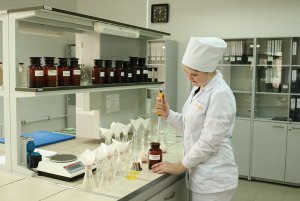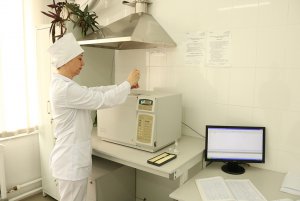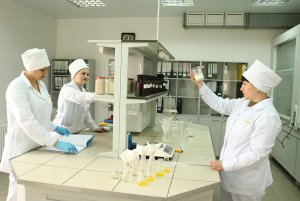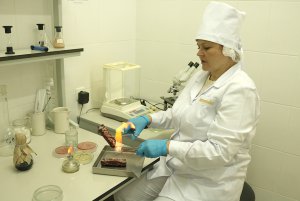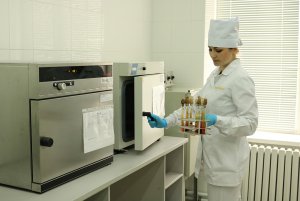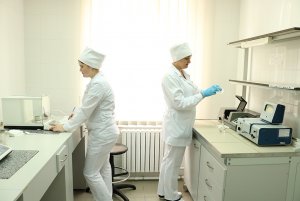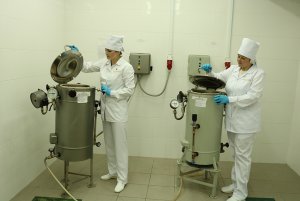Quality guarantee
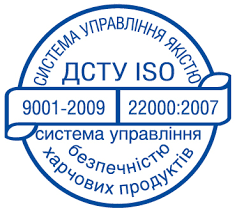
The first thing the enterprise values most of all is quality, and this main principle has been leading the company for more than 100 years. The use of leading production technologies guarantees high-quality products. A strict system of control is implemented at every stage of work.
The production and veterinary control department and laboratory, which are certified according to the existing requirements of the Legislation of Ukraine, control the quality of the raw materials and finished products. At the enterprise, the system of the food safety management functions is certificated and meets the DSTU ISO 22000:2007 requirements (National Standard of Ukraine).
Kremenchukmyaso PrJSC is proud of numerous awards and certificates. And even in periods of economic instability, it does not reduce the quality. Thanks to that fact, it has gained customers' love around Ukraine.
Product quality and safety control
21 employees of the production and veterinary control department of Kremenchukmyaso PrJSC ensure the safety and quality control of the Farro ™ products. This article is a thanksgiving to the team for their work and informative material for people who are interested in the degree of attention paid to product safety and quality. It is all for the enterprise to achieve leading positions in the domestic market and hold high results.
- The department includes two subdivisions of 11 veterinary medicine doctors and ten production laboratory employees. Nowadays, the production laboratory of Kremenchulmyaso is one of the most advanced among other laboratories of the meat production enterprises. Spacious sterile premises of the laboratory are provided with the necessary specialized equipment, reagents, and regulatory documents.
We monitor all the quality and safety indicators that are prescribed by the veterinary legislation of Ukraine. Every stage of the production process is under the close supervision of the laboratory employees: incoming control of raw materials and other stuff, control of the finished product by quality and safety indicators, the sanitary condition of the production, warehouses, and transport, following the production rules and personal hygiene by the production personnel, etc.
- Some main points of the veterinary doctors' work briefly.
- A special place in the control of product safety and quality takes the work of 11 veterinary doctors, who work in the direction of the sanitary examination. They are V.Bozhok, N.Diakon, D.Nelipa, R.Viblyi, A.Frolova, V.Kaplunov, Ye.Zinchenko, T.Bachish, A.Vakulenko, H.Demina, E.Kramar. They are involved absolutely in every stage of production. For example, four people are directly in the slaughterhouse and work at the veterinary-sanitary examination points, which are prescribed by the relevant regulations.
The doctors examine animals before and during the slaughter: they check carcasses, offals for infectious and invasive illnesses, and availability of noncontagious diseases. Infected organs or even carcasses are removed. All the results of the examinations are written in particular journals. At the handover of the meat carcasses from the refrigeration workshop into the sausage one, a veterinary doctor examines the meat for the second time.
The veterinary doctors work in shifts and keep a close eye on everything: they take part in accepting animals, raw materials, and finished products from the sausage workshop, control technological parameters of the production, terms, and conditions of the storage, and sanitary state of the territory of the enterprise and transport, monitor loading of the semi-finished products, draw up accompanying documents, etc. Therefore, the enterprise excludes the risks of receiving poor-quality products.
- How are the product quality and safety controls performed in the production laboratory?
- In the microbiological department, there are two doctors, - Kateryna Diachenko and Tetiana Pustovit, and a laboratory assistant, Nataliia Vasylkova They perform laboratory control of the microbiologic indicators of the raw materials and finished products at the different stages of production. While examining meat, the specialists do a microbiological test, which shows microbial number norm i.e. defines the slaughter hygiene degree, cooling. Most tests are done according to the schedule regulated by a normative document. There is a certain standard for every product control, which depends on the product type. If it is a sausage, then microbiological control of each product kind is performed once every ten days. But process control is carried out upon a production request. Besides, with great attention, we take samples at every stage of making the uncooked smoked sausages, etc.
A large part of the microbiological department's work - is control of washing and disinfection of all production workshops, equipment, vehicles, and production airspace.
We perform meat product testing in compliance with the technical documentation requirements for Physico-chemical quality indicators (nutritional value indicators, dry mass ratio, salt, and moisture content, etc.).
Two doctors in the Physico-chemical department, Iryna Kramarenko and Viktoriia Andrieieva deal with raw material and finished product examination. Upon receiving different meat products, apart from the morphological and chemical carcass contents, organoleptic characteristics are of great importance..
After all, the main indicators of meat quality are appearance, smell, and texture. That is why a commission checks physical and technical indicators of all the assortment produced during 24 hours, as well as organoleptic testing at the daily degustation. Besides, we do some specific examinations of flour for dumplings, for example. For high-quality dumpling production, we need to control a certain percentage of the flour fiber in every batch.
Quality indicators are indicators of protein, carbohydrates, and fat amount. High-quality meat and sausage product manufacturing with a guaranteed safety degree is one of the priority areas of food technology in the XXI century. Food product safety definition includes information about toxic residue content, strictly regulated ecologic toxic substances (namely, heavy metal salts, pesticides, etc.), as well as about microbiological content of the finished products, and the absence of pathogens. Besides, Physico-chemical department employees constantly examine sodium nitrite safety indicators (question about sodium nitrite usage (E250) is so interesting and topical, that we added a separate column with a comment about its content in sausage production).
The radiological department (Alla Kushko)performs a study of the raw materials, which we accept at the enterprise, finished products, and then carries out their random radionuclide examination. This testing shows if an animal grew in the Chornobyl zone or used contaminated food. After all, using radioactive toxic raw materials causes radionuclide accumulation in the human body. Regarding this, we would like to point out that Kremenchukmyaso purchases live cattle only from the domestic producers in Zaporizhzhia, Dnipro, Poltava, and Cherkasy regions, and for many years we have not fixed any of such violations.
The enterprise exports products to Armenia and Vietnam, so we pay special attention to the study of the raw materials for antibiotics and hormones. As lots of antibiotics and hormones are growth stimulants: cattle grow by leaps and bounds, and people can overuse them. On the other side, these medicines for indications from veterinarians are allowed in animal farming. But before the slaughter moment, they have to be removed from the body as a result of the pre-slaughter abstinence for two weeks. Our enterprise regularly controls the availability of these components and performs product examinations in the veterinary medicine state laboratory.
Important tasks of the toxicology department can be figuratively divided into two divisions: one doctor, Liudmyla Butko, performs product examination for organochlorine and organophosphate pesticides, and another one, Yevhenii Yurchenko checks heavy metal salt content. Different researches show that pesticides and heavy metal salt accumulate in the body tissues, and have carcinogenic, mutagenic, neurotoxic, and immunotoxic properties, change the hormonal system, cause anemia, liver diseases, and many others. Taking into account the fact that recently the agricultural sector has considerably increased the use of pesticides, we pay special attention to toxicological control. We determine if the producers overused chemicals, while processing feeding fields, grazed cattle near highways, etc. Another doctor, Olha Vakulenko, controls auxiliary raw material quality: spices, salt, flour, powder milk, sausage casings, packing material, marking availability, etc.
MYTHS AND REALITY: sodium nitrite
Sodium nitrite is the nitric-acid sodium, NaNO2 chemical formula, and white-yellow powder.
It is a traditional ingredient that was added to the sausage content in the 1970s and is obligatory for all sausages produced according to GOSTs.
Why is it added to sausages? To give the sausage an appetizing and plausible pink color, because the normal color of the cooked meat and sausage is grey. Sodium nitrite colors not itself but in combination with myoglobin protein. 6-8g of it for 100kg of the finished product.
Sodium nitrite itself is considered to be a poisonous substance, but its concentration, used in the food industry, is completely harmless. To exceed sodium nitrite safe concentration, a person has to eat about 250kg of sausages at one time! In different studies, you can see mentions of carcinogenic properties of sodium nitrite, however, independent scientific research did not prove this property.
People, who are afraid of eating sausage because of nitrites, are recommended to stop eating spinach, lettuce, cabbage, cauliflower, and other vegetables. In these products, nature foresaw nitrite content more than it is allowed to add in sausages. Nature puts so much nitrite in 1 kg spinach that it is enough to produce 50kg sausage.
Can sodium nitrite be excreted from the body?
Even if you eat sausages every day, sodium nitrite will be excreted from the body again and again. Cholesterol can be accumulated, but sodium nitrite can not as it is not a fat-soluble substance.
Therefore, we can see that sodium nitrite doses in sausages are completely harmless.


